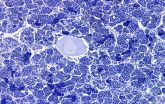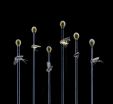(Press-News.org) After six years of painstaking research, a UCLA-led team has validated the first standardized protocol for measuring one of the earliest signs of Alzheimer's disease -- the atrophy of the part of the brain known as the hippocampus.
The finding marks the final step in an international consortium's successful effort to develop a unified and reliable approach to assessing signs of Alzheimer's-related neurodegeneration through structural imaging tests, a staple in the diagnosis and monitoring of the disease. The study is published in the journal Alzheimer's and Dementia.
Using brain tissue of deceased Alzheimer's disease patients, a group headed by Dr. Liana Apostolova, director of the neuroimaging laboratory at the Mary S. Easton Center for Alzheimer's Disease Research at UCLA, confirmed that the newly agreed-upon method for measuring hippocampal atrophy in structural MRI tests correlates with the pathologic changes that are known to be hallmarks of the disease -- the progressive development of amyloid plaques and neurofibrillary tangles in the brain.
"This hippocampal protocol will now become the gold standard in the field, adopted by many if not all research groups across the globe in their study of Alzheimer's disease," said Apostolova, who was invited to play a key role in the consortium because of her reputation as one of the world's leading experts in hippocampal structural anatomy and atrophy. "It will serve as a powerful tool in clinical trials for measuring the efficacy of new drugs in slowing or halting disease progression."
The brain is the least accessible and most challenging organ to study in the human body; as a result, Alzheimer's disease can be diagnosed definitively only by examining brain tissue after death. In living patients, physicians diagnose Alzheimer's by evaluating other health factors, known as biomarkers, in combination with memory loss and other cognitive symptoms.
The hippocampus is a small region of the brain that is associated with memory formation, and memory loss is the earliest clinical feature of Alzheimer's disease. Its shrinkage or atrophy, as determined by a structural MRI exam, is a well-established biomarker for the disease and is commonly used in both clinical and research settings to diagnose the disease and monitor its progression.
But until now, the effectiveness of structural MRI has been limited because of the widely different approaches being used to identify the hippocampus and measure its volume -- which has called into question the validity of this approach. A typical hippocampus is about 3,000 to 4,000 cubic millimeters in volume. But, Apostolova notes, two scientists analyzing the same structure can come up with a difference of as much as 2,000 cubic millimeters.
In addition, no previous study had verified whether estimates for the volume of the hippocampus using MRI corresponded to actual tissue loss.
To address these deficiencies, the European Alzheimer's Disease Consortium-Alzheimer's Disease Neuroimaging Initiative was established to develop a Harmonized Protocol for Hippocampal Segmentation, or HarP -- an effort to establish a definitive method for measuring hippocampal shrinkage through structural MRI in a way that best corresponds to the Alzheimer's disease process.
Once the HarP was established, Apostolova and four other experts were invited to develop the gold standard for measuring the hippocampus to be used by anyone employing the HarP protocol. The UCLA-led team then validated the technique and ensured the changes in the hippocampus corresponded to the hallmark pathologic changes associated with Alzheimer's disease.
"The technique is meant to be used on scans of living human subjects, so it's important that we are absolutely certain that this methodology measures what it is supposed to and captures disease presence accurately," Apostolova said.
To do that, her group used a powerful 7 Tesla MRI scanner to take images of the brain specimens of 16 deceased individuals -- nine who had Alzheimer's disease and seven who were cognitively normal -- each for 60 hours. This provided unprecedented visualization of the hippocampal tissue, Apostolova said.
After applying the protocol to measure the hippocampal structures, the researchers analyzed the tissues for two changes that signify the disease: a buildup of amyloid tau protein and loss of neurons. The team found a significant correlation between hippocampal volume and the Alzheimer's disease indicators.
"As a result of the years of scientifically rigorous work of this consortium, hippocampal atrophy can finally be reliably and reproducibly established from structural MRI scans," Apostolova said.
Although the technique can be used immediately in research settings such as clinical trials, the next step, Apostolova noted, will be to use the standardized protocol to validate automated techniques available for measuring the hippocampus so the approach could be used more widely -- including for the diagnosis of the disease in doctor's offices and other patient care settings.
INFORMATION:
Funding for the study was provided by the National Institute on Aging (P50 AG16570), the Jim Easton Consortium for Alzheimer's Drug Discovery and Biomarker Development, the National Institutes of Health (R01 AG040770), and the Alzheimer's Association (IIRG 10-174022). Please see the paper for a complete list of the study's authors.
MELBOURNE, FLA. -- Reef-building corals, already thought to be living near their upper thermal limits, are experiencing unprecedented declines as the world's oceans continue to warm. New evidence from scientists at Florida Institute of Technology shows there may be some climate refuges where corals will survive in the future.
The study appears in the March issue of Global Change Biology.
Ph.D. student Chris Cacciapaglia and his advisor, Robert van Woesik, hypothesized that not all regions of the oceans are warming at the same rate.
"The idea was to identify regions ...
Tracking the rotation speed of solid planets, like the Earth and Mars, is a relatively simple task: Just measure the time it takes for a surface feature to roll into view again. But giant gas planets Jupiter and Saturn are more problematic for planetary scientists, as they both lack measureable solid surfaces and are covered by thick layers of clouds, foiling direct visual measurements by space probes. Saturn has presented an even greater challenge to scientists, as different parts of this sweltering ball of hydrogen and helium are known to rotate at different speeds, whereas ...
(New York - March 25, 2015) Induced pluripotent stem cells (iPSCs) -- adult cells reprogrammed back to an embryonic stem cell-like state--may better model the genetic contributions to each patient's particular disease. In a process called cellular reprogramming, researchers at Icahn School of Medicine at Mount Sinai have taken mature blood cells from patients with myelodysplastic syndrome (MDS) and reprogrammed them back into iPSCs to study the genetic origins of this rare blood cancer. The results appear in an upcoming issue of Nature Biotechnology.
In MDS, genetic mutations ...
CORVALLIS, Ore. - Deep-water marine fish living on the continental slopes at depths from 2,000 feet to one mile have liver pathologies, tumors and other health problems that may be linked to human-caused pollution, one of the first studies of its type has found.
The research, conducted in the Bay of Biscay west of France, also discovered the first case of a deep water fish species with an "intersex" condition, a blend of male and female sex organs. The sampling was done in an area with no apparent point-source pollution, and appears to reflect general ocean conditions.
The ...
DURHAM, N.C. -- The value of many oceanfront properties on the East Coast could drop dramatically if Congress were to suddenly end federal beach nourishment subsidies, a new study by researchers at three universities finds.
In beach nourishment, new sand, often dredged from nearby inlets or the offshore sea floor, is added to an eroding beach to widen it and help prevent future erosion.
"The expectation that the federal government will continue to provide subsidies for erosion-control measures has significantly inflated property values in many coastal communities," ...
Would-be participants of higher education must be given full and transparent advice before they accumulate debts as students that follow them into the workplace, according to a report published in the International Journal of Pluralism and Economics Education.
Deborah Figart of the School of Education, at The Richard Stockton College of New Jersey in Galloway, says that there is a dearth of pre-loan and post-loan counseling for undergraduate students using student loans to help finance their higher education. She has devised an assignment that can be adapted to a wide ...
A new paper to be published in the journal Zootaxa (April 6, 2015) describes 30 new insect species in a single genus, Megaselia, of the fly family Phoridae. Describing 30 species in a single paper is rare, but what's especially striking is that all these come from urban Los Angeles.
The discoveries come from researchers in the BioSCAN project (Biodiversity Science: City and Nature) at the Natural History Museum of Los Angeles County (NHM). The BioSCAN project is a three year investigation of patterns of biodiversity in and around urban Los Angeles, based on sampling ...
AUBURN, AL - In the production of organic vegetables, nitrogen is important, yet can be quite costly to manage. Nitrogen management is even more challenging when production practices call for the use of polyethylene mulch combined with fertigation. The authors of a new study published in HortScience have found that hydrolyzed fish fertilizer holds promise as an "economically feasible" nitrogen source for growing organic vegetables.
"Soluble organic nitrogen sources suitable for fertigation in organic vegetable production are much needed," said lead author of the study, ...
(SACRAMENTO, Calif.) -- In an editorial posted online today in the Annals of Emergency Medicine, two practicing emergency medicine physicians from the University of California, Davis, and Brown University -- both thought leaders at the forefront of finding solutions to the public health crisis of gun violence -- urge their colleagues to take direct action to protect the health and safety of patients and communities.
Their editorial follows the Feb. 24 call to action by eight health professional organizations, including the American College of Emergency Physicians, and ...
In the year since the World Health Organization (WHO) was first notified of an outbreak of what proved to be Ebola virus disease in the west African country of Guinea, more than 24,000 cases have been reported and over 10,000 individuals have died - primarily in Guinea, Liberia and Sierra Leone. Moreover, countless non-Ebola deaths have occurred as a result of the closing of health systems in those countries, and an international aid effort has invested billions of dollars in control efforts.
In a paper published in the open-access journal PLOS Medicine, experts in ...


